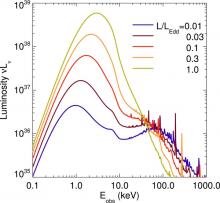
Abstract
We present the results of a new global radiation transport code coupled to a general relativistic magnetohydrodynamic simulation of an accreting, non-rotating black hole. For the first time, we are able to explain from first principles in a self-consistent way all the components seen in the X-ray spectra of stellar-mass black holes, including a thermal peak and all the features associated with strong hard X-ray emission: a power law extending to high energies, a Compton reflection hump, and a broad iron line. Varying only the mass accretion rate, we are able to reproduce a wide range of X-ray states seen in most galactic black hole sources. The temperature in the corona is Te ~ 10 keV in a boundary layer near the disk and rises smoothly to Te ![]() 100 keV in low-density regions far above the disk. Even as the disk's reflection edge varies from the horizon out to ≈6M as the accretion rate decreases, we find that the shape of the Fe Kα line is remarkably constant. This is because photons emitted from the plunging region are strongly beamed into the horizon and never reach the observer. We have also carried out a basic timing analysis of the spectra and find that the fractional variability increases with photon energy and viewer inclination angle, consistent with the coronal hot spot model for X-ray fluctuations.
100 keV in low-density regions far above the disk. Even as the disk's reflection edge varies from the horizon out to ≈6M as the accretion rate decreases, we find that the shape of the Fe Kα line is remarkably constant. This is because photons emitted from the plunging region are strongly beamed into the horizon and never reach the observer. We have also carried out a basic timing analysis of the spectra and find that the fractional variability increases with photon energy and viewer inclination angle, consistent with the coronal hot spot model for X-ray fluctuations.